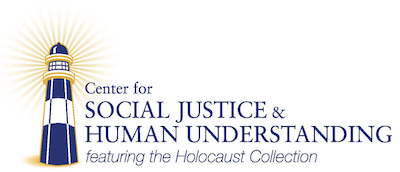Cynthia Eaton
Since 2019, Jill Santiago has been director of the college’s Center for Social Justice and Human Understanding (CSJHU), featuring the Holocaust collection. While located on the Ammerman Campus, the CSJHU makes class presentations and resources available on all three campuses, even bringing materials to classes at Eastern and Grant since they don’t have access to the main collection. During her presentation at our January 10 JEDI Institute meeting, Jill shared that last fall the CSJHU reached 1,200 students through programs and tours. In addition, 1,500 students were engaged with the CSJHU thanks to a grant they had received to increase voter registration and education. Voter registration resources that you can share with students are available on the right column of the CSJHU page on Civic Engagement. The CSJHU website also provides information from the LGBTQ+ task force, including information about campus student organizations, all-gender restrooms, the college’s chosen name policy, the Braver Spaces Allies program for employees and more. Jill was happy to announce that a new initiative this year will be hosting a lavender graduation for students for the first time. In the 1990s, Jill explained, Dr. Ronni Sanlo, a Jewish lesbian at the University of Michigan, was denied the opportunity to attend the graduations of her biological children due to her sexual orientation. This led her to develop the idea of a lavender graduation in 1995. Lisa Hamilton, director of Campus Activities at Grant, has made lavender graduation at SCCC part of her JEDI project. She added that, as advisor to the Grant LGBTQ+ club, this event makes Commencement more unique and special so students can come together as a community. They will be inviting all students who identify as LGBTQ+ through a flyer distributed early in the spring semester. The CSJHU also hosts an undocumented students task force, for which librarians Lisa Melendez and Jenny Farquhar have worked diligently to develop and regularly update a comprehensive immigrant students resource guide so students have access to information about financial resources, immigrant rights, DACA, temporary protective status and pertinent news articles. If you have a student with questions, please refer to the campus contacts who can help them. Jill added, “We will also be hosting a Know Your Rights training on February 26 to educate students and anyone who would like to have more information,” so contact Jill if you would like to learn more. To give more ideas about the kinds of programming offered by CSJHU, Jill shared with the group that last fall, they hosted a banned books readout on September 25, Meet the Author: Tim Keogh’s In Levittown’s Shadow on October 2, “The Battle for Long Island’s Souls and Minds: Resistance Against the Long Island Klan in the 1920s” with Adjunct Assistant Professor of History Christopher Verga, “Enter The House on Mango Street” with Margarita Espada on October 23 and Unity Day featuring a keynote by documentary filmmaker Ken Nwadike, Jr., on October 25. Finally, Jill encouraged the group to explore the CSJHU’s By Design video series. A docuseries focused on historical events that have shaped Long Island, By Design covers a variety of topics, including the following, that we encourage you to view and consider integrating into your classes:
If you would like to learn more or gain access to materials from the Center for Social Justice and Human Understanding or to arrange for Director Jill Santiago to visit your class, contact the CSJHU today. |
